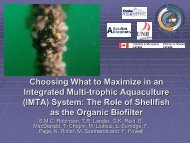Integrated multi-trophic aquaculture (IMTA) in marine temperate waters
Integrated multi-trophic aquaculture (IMTA) in marine temperate waters
Integrated multi-trophic aquaculture (IMTA) in marine temperate waters
Create successful ePaper yourself
Turn your PDF publications into a flip-book with our unique Google optimized e-Paper software.
<strong>Integrated</strong> <strong>multi</strong>-<strong>trophic</strong> <strong>aquaculture</strong> (<strong>IMTA</strong>) <strong>in</strong> mar<strong>in</strong>e <strong>temperate</strong> <strong>waters</strong> 31<br />
and Sweden, Scotland, and Canada), <strong>in</strong>dicate that <strong>in</strong>tegrat<strong>in</strong>g mussels and seaweeds<br />
with exist<strong>in</strong>g salmon monocultures can <strong>in</strong>crease the profits of salmon farmers<br />
while rema<strong>in</strong><strong>in</strong>g environmentally responsible. Also, this <strong>in</strong>crease <strong>in</strong> profitability is<br />
compounded over time, grows with <strong>in</strong>creased production and stock<strong>in</strong>g densities, and<br />
is us<strong>in</strong>g only conservative estimates for seaweed market value. Assum<strong>in</strong>g no major<br />
market changes or die-offs, the outlook for <strong>IMTA</strong> is certa<strong>in</strong>ly promis<strong>in</strong>g.<br />
Explor<strong>in</strong>g additional economic value for <strong>IMTA</strong> coproducts<br />
Besides the commonly cultured f<strong>in</strong>fish, shrimps and bivalves, the economic value of<br />
seaweeds, ech<strong>in</strong>oderms, crustaceans and polychaetes should also be considered for<br />
<strong>IMTA</strong>.<br />
Aquatic plants represent 23.4 percent of the tonnage and 9.7 percent of the value of<br />
the global (mar<strong>in</strong>e, brackishwater and freshwater) <strong>aquaculture</strong> production, estimated<br />
at 59.4 million tonnes and US$70.3 billion <strong>in</strong> 2004. Consider<strong>in</strong>g only mariculture<br />
(50.9 percent of the global <strong>aquaculture</strong>, estimated at 30.2 million tonnes and US$28.1<br />
billion), aquatic plants represent 45.9 percent of the tonnage and 24.2 percent of the<br />
value. Molluscs represent 43.0 percent, fish 8.9 percent, crustaceans 1.8 percent, and<br />
other aquatic animals 0.4 percent (FAO, 2006a). The seaweed <strong>aquaculture</strong> production<br />
(92 percent of the world seaweed supplies) is estimated at 11.2 million tonnes and<br />
US$ 5.7 billion (99.7 percent be<strong>in</strong>g provided by Asian countries). Approximately<br />
220 species of algae are cultivated; however, 6 genera are provid<strong>in</strong>g 94.8 percent of<br />
the seaweed <strong>aquaculture</strong> production (Lam<strong>in</strong>aria [kombu; 40.1 percent], Undaria<br />
[wakame; 22.3 percent], Porphyra [nori; 12.4 percent], Eucheuma/Kappaphycus [11.6<br />
percent] and Gracilaria [8.4 percent]), and 4 genera are provid<strong>in</strong>g 95.6 percent of its<br />
value (Lam<strong>in</strong>aria [47.9 percent], Porphyra [23.3 percent], Undaria (17.7 percent) and<br />
Gracilaria [6.7 percent]).<br />
Accord<strong>in</strong>g to Santos (2006), until recently, the most commonly used seaweeds for<br />
biofiltration <strong>in</strong> Europe belonged to the genera Ulva and Gracilaria. Although their<br />
husbandry is well established, their market value is low, as they are used primarily as<br />
feed or fertilizer. Therefore alternative species of seaweeds with higher market value<br />
are be<strong>in</strong>g explored. For example, Asparagopsis armata has a high value due to its ability<br />
to concentrate halogenated organic metabolites, which can be used for fungicides,<br />
antibiotics and sk<strong>in</strong> cosmetics, with the possibility of patents (Lognone et al., 2003).<br />
Therefore to ensure further expansion of <strong>IMTA</strong>, further research <strong>in</strong>to alternative<br />
species must cont<strong>in</strong>ue or be <strong>in</strong>itiated. As well, new markets for these products should<br />
be sought out to further safe guard economic reward.<br />
As shown <strong>in</strong> Table 2, seaweeds can be highly profitable, assum<strong>in</strong>g grow<strong>in</strong>g<br />
conditions are optimal and market niches have been established. While there exists a<br />
wide range <strong>in</strong> seaweed use (e.g. from fertilizer to human consumption), the value and<br />
quality of the product also have a wide range. These po<strong>in</strong>ts are important to consider<br />
when determ<strong>in</strong><strong>in</strong>g product value.<br />
Other species <strong>in</strong> an <strong>IMTA</strong> system, <strong>in</strong>vertebrates and herbivores <strong>in</strong> general, also have<br />
high economic value. As shown <strong>in</strong> Table 1, molluscs (particularly bivalves) have well<br />
established market value. Other mid-<strong>trophic</strong> animals such as ech<strong>in</strong>oderms, crustaceans<br />
and polychaetes are also economically valuable. Ross, Thorpe and Brand (2004) showed<br />
how sea urch<strong>in</strong>s and crabs can be grown with scallops to prevent biofoul<strong>in</strong>g on nets,<br />
which <strong>in</strong> turn help reduce ma<strong>in</strong>tenance costs and improve growth rates of scallops.<br />
These co-products can also be sold. For example, sea urch<strong>in</strong> gonad (“roe” or “uni”)<br />
is popular <strong>in</strong> Asian sushi restaurants where it can demand prices <strong>in</strong> the range of US$6<br />
to US$200 per kilogram, depend<strong>in</strong>g on quality (Rob<strong>in</strong>son, Castell and Kennedy, 2002;<br />
Rob<strong>in</strong>son, 2004). Therefore to ensure maximal gonad growth and quality, the stage of<br />
gametogenesis (among other factors) must be considered before harvest<strong>in</strong>g (Rob<strong>in</strong>son,<br />
Castell and Kennedy, 2002). However, as wild stocks of sea urch<strong>in</strong>s are <strong>in</strong> decl<strong>in</strong>e, and



